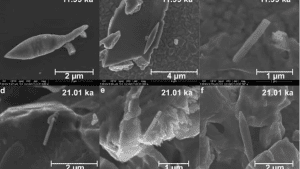TAG: GS 3: SCIENCE AND TECHNOLOGY
THE CONTEXT: Scientists at the CSIR-National Institute of Oceanography, Goa, recently unearthed a significant discovery in the Bay of Bengal—a 50,000-year-old sediment containing giant magnetofossils.
EXPLANATION:
- This finding, published in the journal Nature in February, represents one of the youngest giant magnetofossils discovered to date.
Magnetofossils:
- Magnetofossils are fossilized remnants of magnetic particles produced by magnetotactic bacteria, also known as magnetobacteria.
- These bacteria align themselves along Earth’s magnetic field lines, utilizing tiny crystals of iron-rich minerals like magnetite or greigite to navigate changing oxygen levels in their aquatic environments.
- First described in the 1960s and 1970s, magnetotactic bacteria and their fossilized remains provide insights into ancient environmental conditions.

Needle, spindle, bullet and spearhead shape-magnetofossils
Characteristics of the Sediment
- The sediment core retrieved from the southwestern Bay of Bengal consisted primarily of pale green silty clays.
- High-resolution transmission electron microscopy revealed the presence of magnetofossils shaped like needles, spindles, bullets, and spearheads, alongside conventional magnetofossils.
- The unique characteristics of this sediment core shed light on the environmental conditions prevailing in the late Quaternary period.
Implications of the Discovery
- The discovery challenges previous assumptions about the origins of giant magnetofossils, which were often attributed to events like hyperthermal vents or comet impacts.
- Unlike earlier finds dating back millions of years, this discovery suggests that giant magnetofossils also formed during the late Quaternary period, a mere 50,000 years ago.
Role of Environmental Factors
- Analysis of the sediment sample indicated fluctuations in monsoon activity during the last Glacial Maximum-Holocene period, approximately 29,000 to 11,700 years ago.
- The presence of magnetic minerals from distinct geological periods suggests the influence of rivers like the Godavari, Mahanadi, Ganga-Brahmaputra, Cauvery, and Penner, which discharge into the Bay of Bengal.
Environmental Conditions Favorable for Magnetotactic Bacteria
- The nutrient-rich sediment carried by these rivers provided an abundant supply of reactive iron, which, combined with organic carbon in suboxic conditions, created a conducive environment for magnetotactic bacteria to thrive.
- Additionally, freshwater discharge from rivers and oceanographic processes like eddy formation contributed to oxygenation levels conducive to bacterial growth.
National Institute of Oceanography:
- The National Institute of Oceanography (NIO) is one of the 37 constituent laboratories of the Council of Scientific & Industrial Research (CSIR), New Delhi.
- NIO is headquartered at Dona Paula, Goa, and has regional centres at Kochi, Mumbai and Visakhapatnam.
- NIO was established in 1966 following the International Indian Ocean Expedition (IIOE) in the 1960s.
- It is a multi-disciplinary oceanographic research institute. The major research areas include the four traditional branches of oceanography – biological, chemical, geological/geophysical, and physical – as well as ocean engineering, marine instrumentation and marine archaeology.

